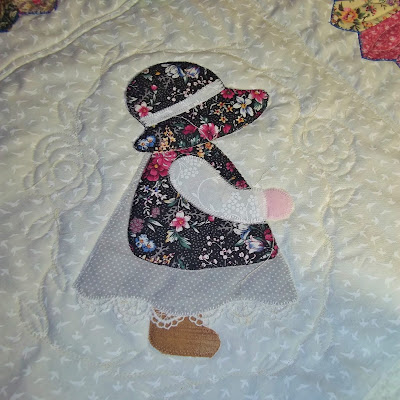Some weeks I seem to slog through the list like a sloth but last week's list was tackled like a BOSS...
✔ The car quilt ~ Rules of the Road ~ was successfully completed and my customer is very pleased with it. She stated "that quilt is one of the cutest ever. The stippling quilting is darling for the cover."
✔ Wedding Quilt... the fabric pull is done and the pattern has been selected.
I'll be creating a heart layout using half-square triangles with a scrappy look of green fabric.
✔ Baby Quilt - DONE! Using a big block pattern, this little quilt was done in a day! I always forget how quickly they can come together.
While it may not be what I consider to be a baby-ish quilt in the primary colors, it will match perfectly with the woodland creatures theme that is oh so popular right now.
Among other things I was able to accomplish...
Since Dave is more focused on prepping for a black powder hunting trip in a few weeks, I have decided that I would turn my attention to Fiona Sandwich's Summer Camp sewing. This type of sewing is usually reserved four our camping trips, but rather than wait for him to take me camping... I have marked a few more items of of the sewing challenge list...
Rachel challenged us to find a fabric that could be used for three different things... The blue fabric I found worked for Sky, Mountains and Water!
The dark sky fabric has some shimmer to it reminding me of how we enjoyed the view of the twinkling stars over the Sangre De Cristo mountain range as we roasted marshmallows over the campfire.
Another block that will be counted as one of 10 - this gives me 6 done, only 4 more to go!
This was the Liberty Bell block that I modified to be a wedding bell with a green background... Janna's & Justin's wedding will be a part of our camping quilt. :)
And the last "camp block" I completed was Devil's Tower. I am hopeful that we will be able to take a bit of a trip after our time in Chicago for the wedding... up into Wisconsin, maybe Minnesota and across the Dakotas and Montana, south across Wyoming and return home in southern Colorado. Devil's Tower is on my radar!
❧I have a few more blocks prepped and will continue marking off challenges. Summer Camp will soon be closing so I hope to get several more challenges done.
I think that will keep me busy for the week...
Have you been to Devil's Tower? What other sights are must see stops on the route that I mentioned?
Leave a comment... I'd love to hear your suggestions!
Piece Out,
Melva
Linking with:
To Do Tuesday at Chris Knits & Sews
Mid-week Makers at Quilt Fabrication
Wednesday Wait Loss at The Inquiring Quilter
Stitch Sew & Show at Life in the Scrap Patch
Put Your Foot Down at For the Love of Geese
Needle & Thread Thursday at My Quilt Infatuation
Can I Get A Whoop Whoop at Confessions of a Fabric Addict
Off The Wall Friday with Nina Marie
Brag About Your Beauties at From Bolt to Beauty
Peacock Party at Wendy’s Quilts and More
Friday Foto Fun at Powered by Quilting
Finished or Not Friday at Alycia Quilts

































